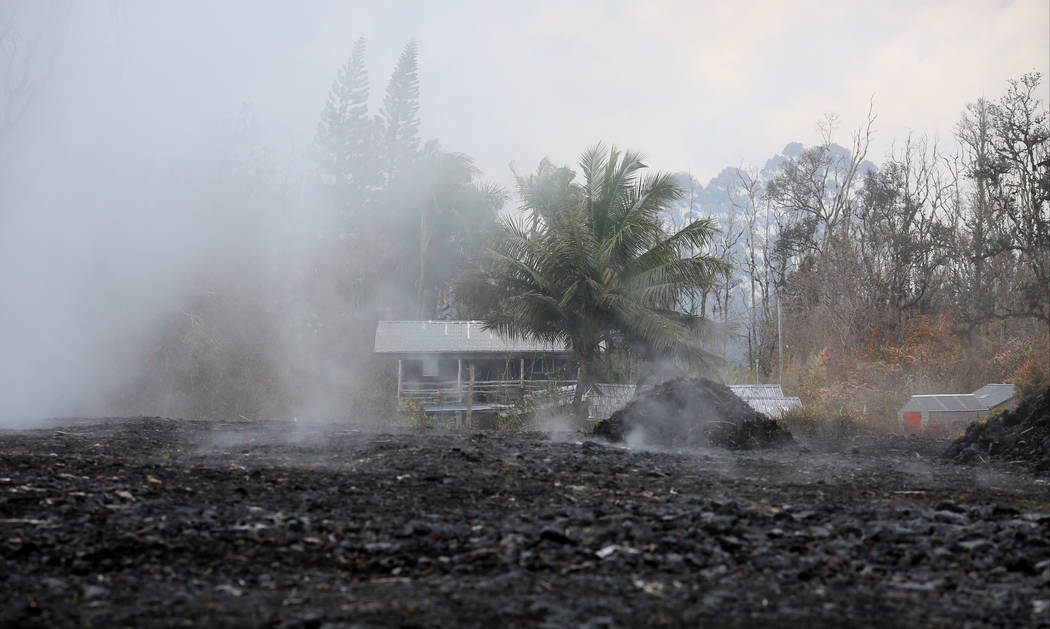Hundreds of Hawaiians wait as Kilauea volcano continues to erupt

PAHOA, Hawaii — Janet Morrow had just turned 16 the day Mount St. Helens blew in 1980, spewing plumes of ash high into the sky above her Washington home.
On Friday, exactly 38 years later, she awoke on her 54th birthday in the cab of her pickup truck, parked at a relief shelter on the Big Island of Hawaii. She slept in the small space with her two dogs and two cats, which she scooped up from within her Leilani Estates home about two weeks ago when evacuations began because of ongoing volcanic eruptions.
“My house is still standing,” Morrow said Friday.
But it’s still not safe enough for her to go home.
“Nobody knows how long it will last,” she said.
Since the Kilauea volcano eruptions began this month, 40 structures have been destroyed, said Talmadge Magno, the director of Hawaii County’s civil defense.
“A lot of the vents rejuvenated and have been putting out lava spatter,” Magno said Friday afternoon. “It’s been pretty active.”
Two communities remain under evacuation — Leilani Estates, where Morrow lives, and Lanipua Gardens. Both are about 20 miles away from the bustling city of Hilo, which remains largely unaffected by the eruptions.
When Kilauea first blew, Morrow recalled feeling several earthquakes from within her home and hearing the crackling and rumbling of the volcano.
Conditions escalated quickly, and soon her entire neighborhood was under evacuation order.
“It smelled like forest fires,” she said.
Her quiet tropical neighborhood soon swelled with cars, filled with people trying to get out of harm’s way.
“The police were driving down the roads with megaphones saying ‘Everyone needs to evacuate now,’” Morrow said. “People were panicking.”
Since then, Morrow has been living out of her truck. She knows she is luckier than some. Several in the shelter have lost their houses, cars and entire properties to lava.
The continuing eruptions bring two significant dangers: lava flow and toxic air.
As of Friday afternoon, 22 fissures had opened in the ground of the affected areas. Most fissures released steam, while some remained extremely active, spewing and sputtering lava from beneath the ground.
The toxicity of the air was greatly reduced Friday thanks to strong breezes that swept through the evacuation zones. The department of health continues to closely monitor air quality, though, since the levels “could change at any time,” department official Fenix Grange said.
While the rest of the island is operating business as usual, the affected areas are closely guarded by law enforcement.
National Guard Humvees crawl down small residential streets, which seem largely unaffected until they are not — where large swaths of lava suddenly and randomly cut off roads, and big cracks appear in the asphalt stemming from the fissures.
As of Friday, nearly 400 people had spent the night in at least one of three relief shelters set up for residents, said Amy Hegy, a spokeswoman with Red Cross Hawaii. More than 600 residents had requested some sort of health or medical assistance, she said, and more than 760 residents had requested mental health services.
Together, they care for each other as they wait for word that it’s safe again.
“You got a lot of people here who are just going with the flow — what will be will be,” Morrow said. “But you’ve got others who are like, where am I going now? They’ve lost everything.”
Even Hawaii Volcano Observatory geophysicist Jim Kauahikaua could not estimate when the eruptions will cease.
Morrow said, “This is Mother Nature. You can’t control it. You can make educated guesses, but it is what it is.”
Contact Rachel Crosby at rcrosby@reviewjournal.com or 702-477-8301. Follow @rachelacrosby on Twitter.